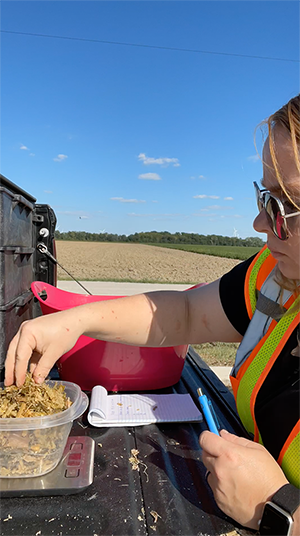
When creating a premium inoculant, BONSILAGE uses a nine-step process that showcases science and real-life trials.
STEP ONE: Isolation of lactic acid bacteria
Every living thing is made from microorganisms, so it’s possible that anything could feature a strain of lactic acid that may be beneficial. This is why BONSILAGE examines a wide variety of substrates; using silages is proven, but vegetables, manure, or other organics can be sources of lactic acid bacteria as well. Thinking outside the box is key.
STEP TWO: DNA sequencing to identify strains
This step is necessary to precisely identify the strains we would like to isolate. Here, we identify the ‘fingerprint’ of the strains for better understanding.
STEP THREE: Gene-expression analysis
Now that a new strain of lactic acid has been identified, how do we tell if it could be beneficial? Gene expression analysis is the study of the way genes synthesize as functional gene products. This study provides insights into normal cellular processes, which tells us whether the characteristics we’re looking for are present in the strain.
STEP FOUR: In vitro lab trials
This is where the rubber hits the road. Or to be more literal, where the strain hits the lab, as researchers attempt to grow the strain in a controlled environment. This complex process involves many trials (and many errors, as is the nature of science!), as we continually fine-tune the ideal way to nurture the strain. Different nutrient media, different pH values, different tolerances, growth rates . . . they can all impact our understanding of where and how to utilize the lactic acid bacteria. So, we test variables in all these directions.
Additionally, we run tests that answer the question, “What are the metabolites?” We do this to better understand growth and reproduction. We also discover the sugar utilization profile, because without carbohydrates, the lactic acid bacteria cannot metabolize anything and form desired acids.
Our in vitro tests go beyond a simple understanding of the strains, however. We also take a deep look at the production and storage properties. A perfect strain is useless if it’s damaged due to improper packing or storage, after all. We explore every angle to provide the best environment possible for the bacteria.
STEP FIVE: Ensiling tests
Now, we run the same series of tests as in step four, but we replicate the ensiling stage on a small scale, using real silage like grass, corn, or alfalfa.
Here, we determine the goals we’re looking to achieve with the strain or strain mixtures and make sure all elements work together as they should. We test different strain combinations and different substrates, as well as examining how they operate after target days of storage.
STEP SIX: Characterization of properties
This step sounds obvious, but it’s also more complicated than that simple categorization. Different markets have different regulations, so certain properties can be required for approval, and certain properties can be cause for disqualification. For example, EU-EFSA and Grass-list USA request different information sets than the other. So, having all your ducks in a row on every product is very important. This is where the safety aspect comes into play. MIC values of the 20 (or so) most common antibiotics are required. We have to prove that they are not antibiotic-resistant, even though they are considered “good” bacteria.
STEP SEVEN: Further laboratory isolation tests
To prepare approval dossiers, we conduct further testing at ISF Schaumann Research, our central think tank, and in conjunction with Lactosan, our in-house manufacturer of products based on live lactic acid bacteria, as well as with external laboratories in Europe and the U.S. But the strains are not only tested in internal and external labs; they’re also put to the test at the official institutions that register our strains in order to confirm their safety and performance. This is accomplished initially during registration (with different registration institutes for EU and the U.S.), but also monitored continuously.
STEP EIGHT: Silage trials with strain mixtures on a practical scale at Gut Huelsenberg
Lab testing is a vital cog in the machine, but it’s all for naught without live in-the-field application. Gut Huelsenberg, BONSILAGE’s own research farm for feeding and ensiling trials, provides us with real-world results to back up our extensive laboratory trials.
STEP NINE: Silage trials with strain mixtures on a practical scale on other farms
And finally, just to provide an external view of our conclusions, the product is tested at working farms around the world.
BONSILAGE prides itself on the comprehensive use of science, research, and real-world trials when developing silage inoculants. Because we’ve targeted specific characteristics in every strain to precisely define performance, our products do exactly what we want them to do. This means we fully trust our product in our own fields and with our own animals, so our producers can trust them with theirs.
